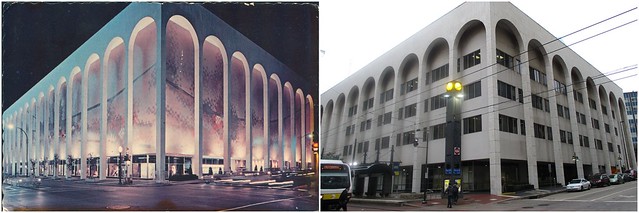- Ask DART
- About
- News
Adaptive Reuse Brought New Purpose to Old Buildings
 Sanger-Harris building - City of Dallas Office of Historic Preservation
Sanger-Harris building - City of Dallas Office of Historic Preservation
If the arches at DART Headquarters at Akard Station remind you of the Foley’s department stores you used to visit, it’s for good reason. DART purchased the Sanger Harris building – a former department store that became Foley’s – and remodeled it into a business office.
The practice is known as adaptive reuse, which is reusing an existing building for a purpose other than that for which it was originally built or designed.
Interestingly, the Dallas College El Centro Campus building was a Sanger Harris store before the company opened its new flagship store at Pacific and Akard where DART now resides.
DART Police Headquarters at Illinois Station is also an adaptive reuse project. The police facility was built within the Monroe Shops, a former interurban streetcar repair facility.
Rather than creating new demolition and construction waste, adaptive reuse allows organizations like DART to save a building from entering the landfills. Restoring an existing building also takes far less energy and resources compared to constructing a new one and generates fewer carbon emissions and other gases.
As Carl Elefante, the 2018 president of the American Institute of Architects (AIA), famously said, “The greenest building is one that is already built.”
DART Police Headquarters is also a “green building” for other reasons. During abatement and demolition, the agency’s contractors remediated the brownfield site and diverted approximately 92% of all construction waste from landfills. DART also installed Energy Star®-rated systems, daylight-responsive controls, and water-efficient faucets, shower heads and toilets to reduce power and water consumption.
In 2011, DART Police Headquarters (Monroe Shops) was honored by the United States Green Building Council (USGBC) as first publicly owned building listed on the National Register of Historic Places to achieve LEED® Platinum Certification (the highest recognition).
Categories : DART Daily Knowledge - Community
Adaptive Reuse Brought New Purpose to Old Buildings
 Sanger-Harris building - City of Dallas Office of Historic Preservation
Sanger-Harris building - City of Dallas Office of Historic Preservation
If the arches at DART Headquarters at Akard Station remind you of the Foley’s department stores you used to visit, it’s for good reason. DART purchased the Sanger Harris building – a former department store that became Foley’s – and remodeled it into a business office.
The practice is known as adaptive reuse, which is reusing an existing building for a purpose other than that for which it was originally built or designed.
Interestingly, the Dallas College El Centro Campus building was a Sanger Harris store before the company opened its new flagship store at Pacific and Akard where DART now resides.
DART Police Headquarters at Illinois Station is also an adaptive reuse project. The police facility was built within the Monroe Shops, a former interurban streetcar repair facility.
Rather than creating new demolition and construction waste, adaptive reuse allows organizations like DART to save a building from entering the landfills. Restoring an existing building also takes far less energy and resources compared to constructing a new one and generates fewer carbon emissions and other gases.
As Carl Elefante, the 2018 president of the American Institute of Architects (AIA), famously said, “The greenest building is one that is already built.”
DART Police Headquarters is also a “green building” for other reasons. During abatement and demolition, the agency’s contractors remediated the brownfield site and diverted approximately 92% of all construction waste from landfills. DART also installed Energy Star®-rated systems, daylight-responsive controls, and water-efficient faucets, shower heads and toilets to reduce power and water consumption.
In 2011, DART Police Headquarters (Monroe Shops) was honored by the United States Green Building Council (USGBC) as first publicly owned building listed on the National Register of Historic Places to achieve LEED® Platinum Certification (the highest recognition).
Categories : DART Daily Knowledge - Knowledge
Adaptive Reuse Brought New Purpose to Old Buildings
 Sanger-Harris building - City of Dallas Office of Historic Preservation
Sanger-Harris building - City of Dallas Office of Historic Preservation
If the arches at DART Headquarters at Akard Station remind you of the Foley’s department stores you used to visit, it’s for good reason. DART purchased the Sanger Harris building – a former department store that became Foley’s – and remodeled it into a business office.
The practice is known as adaptive reuse, which is reusing an existing building for a purpose other than that for which it was originally built or designed.
Interestingly, the Dallas College El Centro Campus building was a Sanger Harris store before the company opened its new flagship store at Pacific and Akard where DART now resides.
DART Police Headquarters at Illinois Station is also an adaptive reuse project. The police facility was built within the Monroe Shops, a former interurban streetcar repair facility.
Rather than creating new demolition and construction waste, adaptive reuse allows organizations like DART to save a building from entering the landfills. Restoring an existing building also takes far less energy and resources compared to constructing a new one and generates fewer carbon emissions and other gases.
As Carl Elefante, the 2018 president of the American Institute of Architects (AIA), famously said, “The greenest building is one that is already built.”
DART Police Headquarters is also a “green building” for other reasons. During abatement and demolition, the agency’s contractors remediated the brownfield site and diverted approximately 92% of all construction waste from landfills. DART also installed Energy Star®-rated systems, daylight-responsive controls, and water-efficient faucets, shower heads and toilets to reduce power and water consumption.
In 2011, DART Police Headquarters (Monroe Shops) was honored by the United States Green Building Council (USGBC) as first publicly owned building listed on the National Register of Historic Places to achieve LEED® Platinum Certification (the highest recognition).
Categories : DART Daily Knowledge - Leading Mobility
- language



 Translate
Translate
Leave a comment